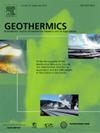Marine geothermal study in shallow stratigraphic wells on the Kara sea shelf: high-resolution thermal conductivity and temperature data
IF 3.9
2区 工程技术
Q3 ENERGY & FUELS
引用次数: 0
Abstract
For the first time in the marine geothermal research practice, multiscale rock heterogeneity and anisotropy were studied with continuous thermal property profiling on whole core column from shallow stratigraphic wells on the Kara Sea shelf that improved heat flow assessment. The thermophysical core logging technology, which allows specialists to provide continuous non-destructive profiling of rock thermal properties with spatial resolution of 1 mm, was utilized for the first time in marine wells. This approach yielded high-quality data on thermal conductivity, volumetric heat capacity, and thermal diffusivity for all drilled 916 full-size core samples, accounting for their thermal heterogeneity and anisotropy. Additionally, 30 core samples were selected based on thermal profiling results for extended thermophysical studies: 25 samples were scanned after additional saturation, 5 samples were prepared and studied within the temperature range from 20 to 80 °C using the divided bar technique, and 5 samples were studied at increased up to 5 MPa uniaxial pressure. Heat flow was estimated using the equivalent thermal conductivity, which was determined accounting for each core sample length, macro- and microanisotropy of the rocks, the core decompression, the drying of samples during transportation and storage, and thermobaric conditions of the drilled sediments. The research aims to create a database on geothermal characteristics to improve the reliability of hydrocarbon exploration and development on the studied territory of the Kara Sea shelf. The applied technology for experimental geothermal research allows specialists for extensive and more representative studies of the subsurface geothermal characteristics on the shelf, compared to the traditional approaches that rely on measurements in near-bottom sediments.
喀拉海陆架浅层地层井的海洋地热研究:高分辨率导热系数和温度数据
在海洋地热研究实践中,首次通过对喀拉海陆架浅层地层井全岩心柱连续热物性剖面研究了岩石的多尺度非均质性和各向异性,改进了热流评价。热物理岩心测井技术,使专家能够提供1毫米空间分辨率的岩石热特性连续无损剖面,首次应用于海井。该方法获得了所有916个全尺寸岩心样品的导热系数、体积热容量和热扩散率的高质量数据,说明了它们的热非均质性和各向异性。此外,根据热剖面结果选择30个岩心样品进行扩展热物理研究:25个样品在额外饱和后进行扫描,5个样品在20 - 80°C的温度范围内使用分棒技术进行制备和研究,5个样品在单轴压力增加至5 MPa的情况下进行研究。根据岩心样品长度、岩石的宏观和微观各向异性、岩心减压、运输和储存过程中样品的干燥以及钻探沉积物的热压条件,利用等效导热系数估算了热流。该研究旨在建立地热特征数据库,以提高喀拉海陆架研究区域油气勘探开发的可靠性。与依赖于近海底沉积物测量的传统方法相比,实验地热研究的应用技术使专家能够对大陆架上的地下地热特征进行广泛和更具代表性的研究。
本文章由计算机程序翻译,如有差异,请以英文原文为准。
求助全文
约1分钟内获得全文
求助全文
来源期刊

Geothermics
工程技术-地球科学综合
CiteScore
7.70
自引率
15.40%
发文量
237
审稿时长
4.5 months
期刊介绍:
Geothermics is an international journal devoted to the research and development of geothermal energy. The International Board of Editors of Geothermics, which comprises specialists in the various aspects of geothermal resources, exploration and development, guarantees the balanced, comprehensive view of scientific and technological developments in this promising energy field.
It promulgates the state of the art and science of geothermal energy, its exploration and exploitation through a regular exchange of information from all parts of the world. The journal publishes articles dealing with the theory, exploration techniques and all aspects of the utilization of geothermal resources. Geothermics serves as the scientific house, or exchange medium, through which the growing community of geothermal specialists can provide and receive information.
 求助内容:
求助内容: 应助结果提醒方式:
应助结果提醒方式:


